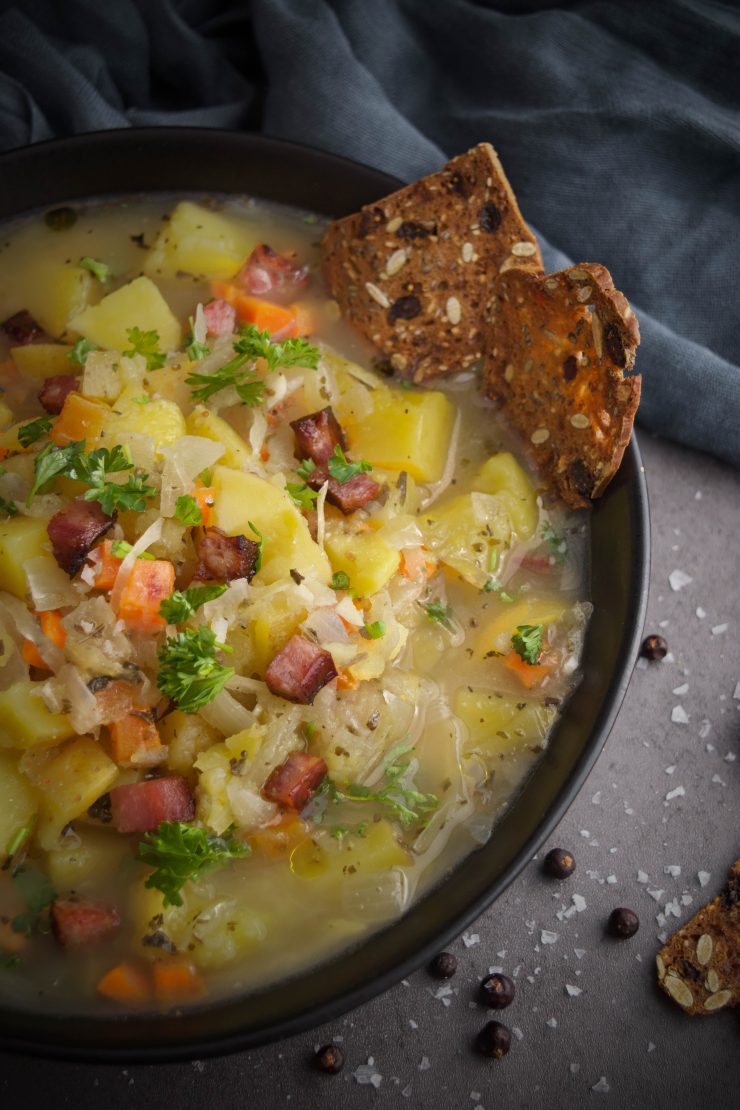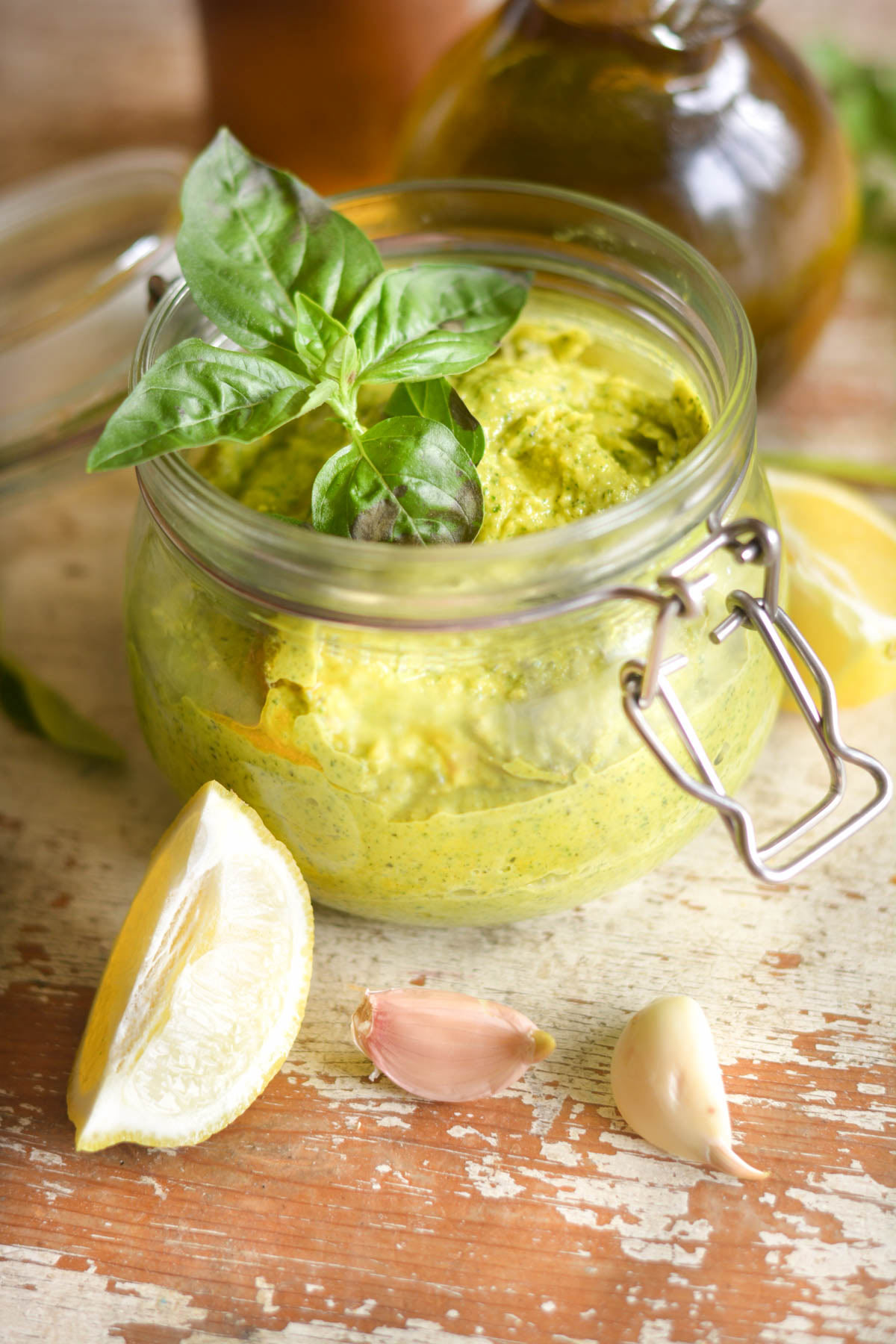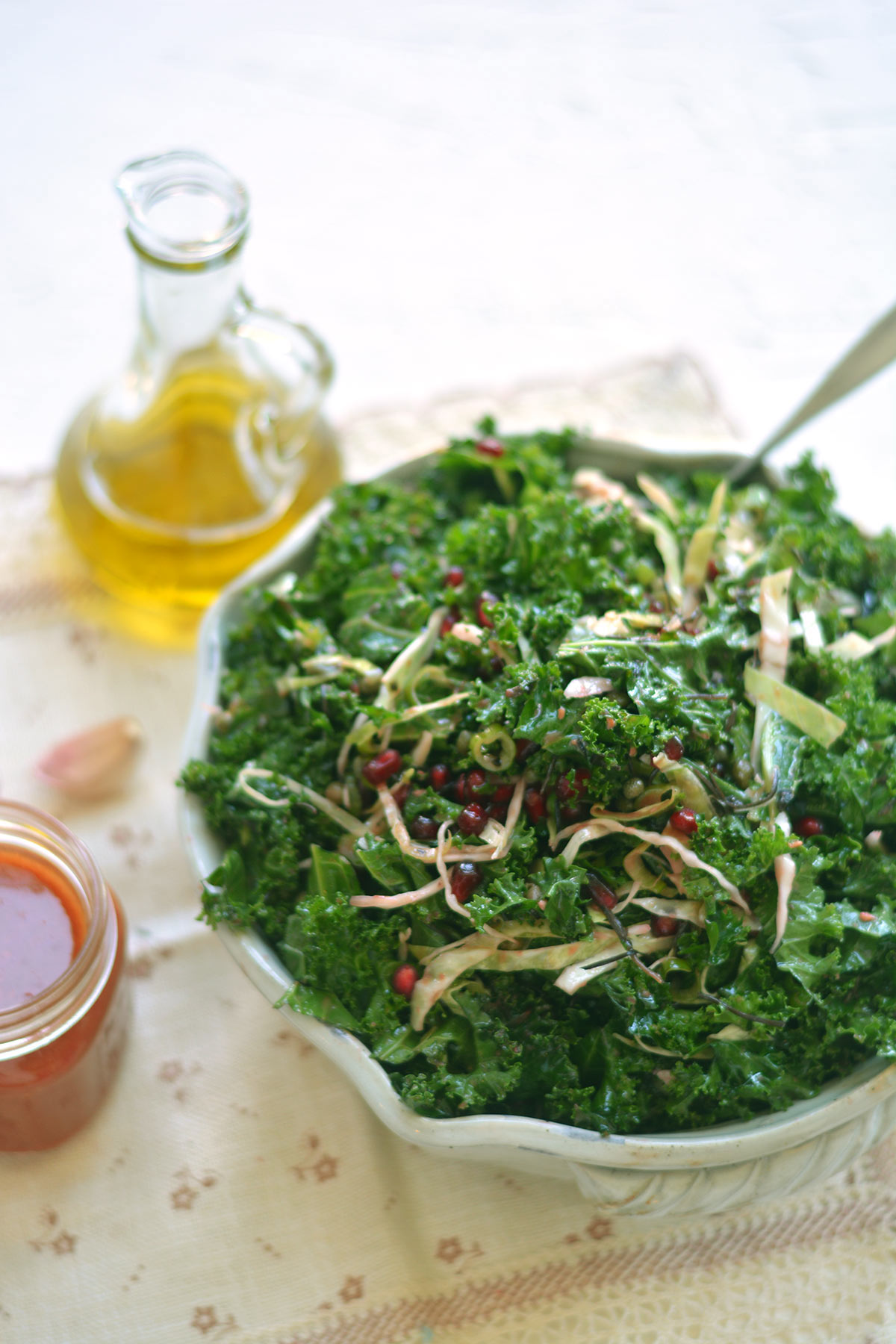Traditional Polish Kapusniak Soup Recipe (Sauerkraut Soup)
Kapusniak is a hearty and nutritious Polish soup made from sauerkraut or fermented cabbage, potatoes, carrots, and onions. It is the heartiest soup you have ever tried. If you like all things sauerkraut, this hot soup should be on your list!

Kapusniak- Polish Sauerkraut Soup
Kapusniak is a traditional Polish soup that has been enjoyed for centuries. Its name comes from the Polish word for sauerkraut, “kapusta kiszona.”
Sauerkraut is a crucial component of this soup, and it gives the dish its distinctively tangy flavor. The process of making sauerkraut involves fermenting cabbage in salt water, resulting in a sour taste that adds complexity and depth to the soup. The sauerkraut used in kapusniak is typically cooked with meat and other vegetables, such as carrots and onions, to create a rich and savory broth, but it can also be made vegetarian or vegan.
This is my family’s traditional recipe you will enjoy on a cozy winter evening or a cold day. Eastern Europeans love this sour soup!
Cabbage, the Polish love affair!
Cabbage – kapusta is one of the most popular vegetables in Polish cuisine. Poles use it for soups, stews, salads, sauerkraut, golabki, hunter stew, pierogi and more.
Sauerkraut is a fermented cabbage that has a lot of fantastic health properties, such as:
- Improves digestion: Sauerkraut is a rich source of probiotics, which are live bacteria that help to improve digestion and maintain a healthy balance of gut bacteria. These probiotics can help to alleviate digestive issues such as bloating, gas, and constipation.
- Boosts immunity: Sauerkraut is also rich in vitamin C, which is a powerful antioxidant that can help to boost the immune system and protect against illness and disease. Vitamin C also helps to support the body’s natural healing processes.
- Lowers inflammation: Sauerkraut contains compounds called isothiocyanates, which have been shown to have anti-inflammatory effects in the body. This can help reduce the risk of chronic inflammation, which is associated with various health problems, including heart disease, arthritis, and cancer.
- Supports heart health: Sauerkraut is a good source of fiber, which can help to lower cholesterol levels and reduce the risk of heart disease. The probiotics in sauerkraut may also help to lower blood pressure and reduce the risk of heart attack and stroke.
- May help with weight loss: Sauerkraut is low in calories and high in fiber, which can help to promote feelings of fullness and reduce appetite. This can be helpful for people who are trying to lose weight or maintain a healthy weight.
- May improve mental health: The probiotics in sauerkraut may also positively affect mental health, as research has shown that gut health is closely linked to mental health. Some studies have suggested that probiotics may help to alleviate symptoms of depression and anxiety.
Do I have to say more to invite you to make kapusniak?

What Is Kapusniak Polish Sauerkraut Soup?
Kapusniak, Polish Sauerkraut Soup, has a long history in Eastern Europe, and it is believed to have originated in Poland. The soup was originally made with fresh cabbage, but over time, sauerkraut became the preferred ingredient. Sauerkraut is made by fermenting cabbage with salt and other spices, which gives it a tangy and sour flavor. The fermentation process also creates probiotics and other beneficial bacteria, which are good for the digestive system.
In Poland, kapusniak is a traditional dish that is often served during the winter months. It is a popular soup in many Eastern European countries, including Russia, Ukraine, and Lithuania, where it is known as kapustnyak. Kapusniak is a popular dish and staple food in many households, and every family has their unique recipe.
Ingredients Used in Kapusniak
The main ingredients in this Polish cabbage soup are potatoes and sauerkraut, which is readily available in most grocery stores. The sauerkraut is usually rinsed before being added to the soup to reduce the sourness. Other ingredients that are commonly used in kapusniak include:
- Meat: Kapusniak can be made with different types of meat, including pork ribs, beef, chicken, or Polish sausage. The meat is usually browned in a skillet before being added to the soup.
- Vegetables: Kapusniak is often made with a variety of vegetables, including onion, carrots, celery root, parsley root, and potatoes. These vegetables add flavor and nutrition to the soup.
- Spices: Kapusniak is typically seasoned with bay leaves, caraway seeds, peppercorns, allspice, marjoram, juniper berries, and garlic. These spices give the soup a rich and savory flavor.
Some variations of kapusniak may also include other ingredients such as mushrooms, beans, or barley. The recipe can be adjusted based on personal taste preferences and dietary restrictions.

How to Make Kapusniak
This Polish kapusniak – sauerkraut soup recipe is a simple soup but requires time and patience. The soup can be made on the stovetop or in a slow cooker, and the recipe can be adjusted based on personal preference. Here I’m sharing my family recipe for Polish sauerkraut soup recipe.
This Polish winter soup tastes best when simmered for long hours and even better the next day when it soaks in all the flavor! So, we Poles always make big batches of it and eat it throughout the week and during those lazy weekends in colder months.
- Rinse the sauerkraut in a colander and set it aside. (optional- I like it sour, so I don’t rinse it, and I add the juice from the kraut as well)
- Heat olive oil or butter in a large pot or Dutch oven over medium-high heat. Add the meat and cook until browned on all sides. Remove the meat from the pot and set it aside.
- Add the onion and carrots to the large soup pot and cook until soft and translucent.
- Add the garlic, bay leaves, peppercorns, juniper berries, caraway seeds, and allspice to the pot and stir for about 1 minute.
- Add diced potatoes and cook for one hour.
- Add the sauerkraut and the juice to the pot and turn off the heat. Mix the sauerkraut in.
- Dice the bacon and place smoked bacon in a pan on medium heat and wait until the bacon fat melts and the bacon turns brown (about 10 minutes).
- Slice or chop the sausage and fry it in the frying pan.
- Remove the bay leaves from the soup pot, and season the soup with salt and pepper to taste.
If you like your soup thicker, you might make a half-and-half slurry.
Tips For Making The Best Kapusniak
- This soup is gluten-free! If you use sausage, just make sure that it is gluten-free!
- Buy the sauerkraut in a Polish deli or buy one from the company called “Bubbies” by fat THE BEST SAUERKRAUT on the market. Trust me on this one, or better yet, use homemade sauerkraut.
- You can thicken the soup using a gluten-free flour roux or half-and-half slurry with arrowroot.
- If you want it tangier, you can also add a little bit of sour cream or some sauerkraut juice.
- For the vegan option, use cashew cream and add more sauerkraut juice.
- Serve with sourdough bread, gluten-free bread, or rye bread.
- Top with fried sausage or fried bacon, sour cream, or parsley before serving.
Different Variations:
- Vegetarian or Vegan kapusniak: omit the meat and the chicken broth and use vegetable stock instead of water.
- Mushroom kapusniak: add sliced mushrooms to the pot along with the sauerkraut.
- Barley kapusniak: add 1 cup of barley to the pot along with the sauerkraut and water, and simmer until the barley is cooked through.

How to Store Kapusniak?
Kapusniak can be refrigerated for up 5 days or frozen for up to 3 months.
How to Serve
Serve with a dollop of sour cream, bacon, chopped parsley, a slice of rye bread, or fresh crusty bread. The Bowl of this hearty soup is nutritious and delicious!
It is important to note that sauerkraut is high in sodium, so it should be consumed in moderation, especially by people who are sensitive to salt or have high blood pressure. Additionally, people with certain medical conditions or who are taking certain medications should speak with their doctor before adding sauerkraut to their diet.
Did you make this recipe?
Please let me know how it turned out for you! Leave a comment below and share a picture on Instagram with the hashtag #thetastesoflifeholisticblog
More Soup Recipies
Creamy Yellow Pepper Bisque and Cashews Gremolata

Traditional Polish Kapusniak Soup Recipe (Sauerkraut Soup)
Ingredients
- 1 lbs Carrots Diced
- 1 Parsnip Diced
- 1 Onion Diced
- 3 lbs Potatoes Diced
- 1 lbs Pork ribs
- 2 Veggie or chciken broth 32 oz
- 1/2 lbs Smoked Polish Sausage Small dice
- 4 strips Smoked bacon Diced
- 2 tbsp Oilive oil
- 1 jar Sauerkraut From Bubbies company
- 2 tbsp Onion granules
- 2 tbsp Basil
- 2 tbsp Marjoram
- 2 tbsp Garlic powder
- Black pepper To taste
Instructions
- Rinse the sauerkraut in a colander and set it aside. (optional- I like it sour, so I don't rinse it, and I add the juice from the kraut as well)Heat olive oil or butter in a large pot or Dutch oven over medium-high heat. Add the meat and cook until browned on all sides. Remove the meat from the pot and set it aside.Add the onion and carrots to the large soup pot and cook until soft and translucent.Add the garlic, bay leaves, peppercorns, juniper berries, caraway seeds, and allspice to the pot and stir for about 1 minute.Add diced potatoes and cook for one hour.Add the sauerkraut and the juice to the pot and turn off the heat. Mix the sauerkraut in. Dice the bacon and place smoked bacon in a pan on medium heat and wait until the bacon fat melts and the bacon turns brown (about 10 minutes).Slice or chop the sausage and fry it in the frying pan.Remove the bay leaves from the soup pot, and season the soup with salt and pepper to taste.If you like your soup thicker, you might make a half-and-half or water slurry. (An arrowroot slurry is a mixture of arrowroot powder and water that is often used as a thickening agent in cooking. Here's how you can make it:Add the arrowroot slurry to your recipe as a thickening agent. Be sure to stir it into your recipe well ,and allow it to cook for a few minutes to thicken properly.) 2 tablespoons arrowroot powder 2 tablespoons half and half or water In a small bowl, mix together the arrowroot powder and cold half and half). Use a spoon or whisk to stir the mixture until it forms a smooth, thick paste. Gluten free roux:1/4 cup gluten-free flour 1/4 cup fat (butter, olive oil).Melt the fat in a saucepan over medium heat. Add the flour or starch and whisk continuously until it forms a smooth paste. Continue cooking the roux, constantly stirring, until it turns a light golden brown color. Remove the roux from heat and use it immediately tothicken your recipe. Note that gluten-free flours may have different thickeningproperties than wheat flour, so you may need to adjust the amount of roux youuse depending on the recipe) .11. Serve the kapusniak hot,with a dollop of sour cream on top, sausage and bacon if desired.
Notes
- Vegetarian or Vegan kapusniak: omit the meat and the chicken broth and use vegetable stock instead of water.
- Mushroom kapusniak: add sliced mushrooms to the pot along with the sauerkraut.
- Barley kapusniak: add 1 cup of barley to the pot along with the sauerkraut and water, and simmer until the barley is cooked through.






